Climate Change Part 3 - Developers in a climate crisis?
Posted Wednesday, December 11, 2019

Why does the climate crisis matter to me as a developer, and what can I do about it?
The third of our Climate Change series is our On-the-block edition which looks at what can be done by apartment block developers to address climate change issues that will affect the property sector.
You care about the environment - but is this reflected in your work? You build apartment blocks for the people who need them, supporting the people of England and Wales. This is amazing! But, think for a minute about how you do this. Are you taking all the necessary and easy steps required to make your buildings environmentally sustainable?
We’ve already said that “80% of the building stock in the UK for 2050 has already been built, with no thought to energy efficiency or carbon emissions”. Changes that are made must deliver net zero carbon pollution by 2030 - only 10 years away. There is no room for false promises, we need serious adjustments to building practices and regulations that are integrated across developers and other stakeholders.
Two actions towards ‘greening’ the property industry are retrofitting and green design of new buildings. What is green building? what does it mean?
Retrofitting works by
- Double-glazing to reduce heat loss via windows, and reduce energy-usage in flats and overall for blocks
- Green roofing and reflective paints in hot countries can cool buildings and save money otherwise spent on A/C
- Solar panels - expensive to install, but save energy and money long-term. Careful location and positioning, and estimating software can determine how much potential energy can be collected and saved. Energy can be pooled and used to power common areas!
Green design is all about
- Foundations - durable materials like brick, stone, and concrete live longer and have less impact on the environment when demolished than other substances.
- Reusing recycled lumber, plastic, and glass rather than buying new materials - this is cheaper and less impacting on the environment
- Installing geothermal heating - warming homes with pipes underground leading to a heat pump to heat or cool the building. This only requires a small amount of electricity to run and saves money and energy. (take a look at geothermal heaters used in real apartment blocks)
- Window placement - innovative technology can help find the most strategic window placement to use sunlight and natural breezes.
Barriers to green design - why aren’t these things default?
Solar panels are still too pricey for the average person to afford. Living in an apartment also restricts the ability of people to harvest solar power; roofs typically don’t have enough room for every person in the block to have a panel. That would be mayhem!
Efficient new-builds, despite best having best interests at heart, don’t address the issue in real terms. They only reduce predicted emissions growth, not the overall output. Energy management strategies to bring existing ‘floor space’ up to and beyond required standards require retrofitting to the highest energy efficiency standards possible.
Rabbit in the headlights - lethally legal
Failure to correctly account for your emissions and exposure to climate-change-induced risks could leave you standing in the proverbial legal issues headlights. Between 2014-17, ExxonMobil shareholders in Texas alleged that decreased shares value as due to misrepresentations, or omissions on climate change-related risks.
In the UK, activists ClientEarth announced that 3 insurance firms have been reported to Financial Conduct Authority for failure to disclose climate risks in annual reports.
Get money-info
Getting information on how to access energy-performance retrofitting comes with a price - one which without investment and access to financing, might get in your way. Coordinating with stakeholders and city authorities is a vital solution to sustainably building apartment blocks, working closely with all people involved. This includes national and regional governments, home-owners, developers and financiers, building trades, industries and energy utilities. HOWEVER, we all know that plans made are not always plans followed-through - coordination of stakeholders isn’t an easy dance to conduct and can be time-consuming.
Precious time that we do not have.
Overcoming the hurdles which stand in the way of green design is vital to its normalisation. Instead of seeing green buildings as innovative, crazy and pretty to look at, they need to be the default. Surely ‘mainstream’ should be the best-sort-of-stream?
What do green buildings look like?
If you’re still unsure about what we mean by ‘green building’, try taking a look at some of these -
London's coolest sustainable builds (some say)
Despite this blog’s urgent message for “green-building-a-go-go”, the UK is in some cases already ahead of the game - Shanghai Tower in London has been designed with a huge exterior solar-farm (Read more about it here) - food for thought perhaps??
What can I get started on right away?
The World Economic Forum (WEF) has some tips for developers:
- Set the highest standards you can, and monitor your performance. Not only does this give you credibility as a business, but improves your market signals to attract a workforce of environmentally-committed people.
- Commit to continuous improvement in environmental performance in construction and development activities - don’t cop-out with a once-off target! This won’t actually do you any good, or protect you from unforeseeable climate-emergencies.
- Linking on from this, track your exposure to risk from environmental regulations and impacts of climate change to reduce your vulnerability and ensure a secure future for your business.
The Energy Sector Management Assistance Programme (ESMAP - read here for more) suggests:
- Improved design and construction techniques which reduce heating, cooling, ventilating and lighting loads – introduce and enforce Building Energy Efficiency Codes, which set the minimum energy efficiency requirements of a building (including thermal performance)
- Upgrading buildings and replacing energy-using equipment
- Actively managing energy use – effective energy management systems for monitoring and controlling energy use in large apartment blocks like Smart Meters. If residents can see how much they are spending on energy, they’re likely to use less!
Though some of this is repetition, this is proof that sustainable building doesn’t have to be complicated. There is already unison on the matter from independent sources, so why can’t we get on with it?
Can I really make a difference though? What if I’m a small developer?
Of course!
WEF say that “city-scale” actions could reduce global greenhouse gas emissions by 3.7Gt of carbon dioxide equivalent (a measure of gas relative to how much it affects the atmosphere compared to carbon dioxide, usually shown by CO2e) by a projected 2030 scenario, and by a huge 8.0Gt in 2050! To put these numbers into context, global emissions from industry and fossil fuels reached a record 36.2Gt in 2018.
Water and space heating improvements could amount to a 1.1Gt reduction in CO2e annually by 2030, and 2.0Gt in 2050.
See a pattern here?
Take some time to think about the strategies that you could implement as a developer, or as an employee to a developing company. What suggestions could you make? This stuff can be overwhelming, but there are plenty of resources (listed below are a few) which can enlighten you further on how to enter the cornucopia that is green-building.
Okay. Do sustainable buildings work in real life? Will I lose money?
A study by the World Economic Forum (WEF) found that people perceive green building construction as being 14% more expensive than the norm. In fact, green buildings are on average 2% more expensive than regular builds and have the potential to reap more benefits than you might imagine. The next few blogs will cover how green buildings can make YOU MORE MONEY and PROTECT YOUR FINANCIAL SECURITY.
Sources:
https://www.buildsoft.com.au/blog/10-steps-to-building-eco-friendly
http://www3.weforum.org/docs/GAC16/CRE_Sustainability.pdf
https://www.lowtechmagazine.com/2016/05/how-to-go-off-grid-in-your-apartment.html
https://www.worldgbc.org/what-green-building

